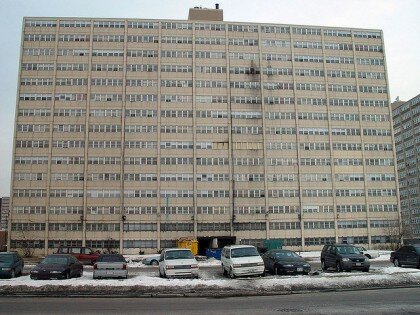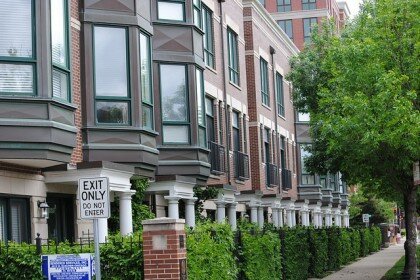A Tale of Two Mixed-Income Communities: East Lake in Atlanta finds the right formula, but Chicago struggles with Cabrini-Green
I spent the day visiting an inspiring community in Atlanta last week. is living proof that a comprehensive approach to poverty—one that considers more than housing, more than just income, more than just a job, and more than just a good school, but all of those elements combined—can make a lasting impact on children’s lives.
My host was , president of in Atlanta, and we were standing on the playground in an Atlanta neighborhood once so awful that it was called Little Vietnam for its war zone qualities. As the former mayor Shirley Franklin told me, “Even I didn’t want to drive through there.”
On this day, however, kids in matching uniforms were running and shrieking, hanging from modern monkey bars and arguing over the rules of their made-up games. I’d just taken a tour of the school, where light streamed in, libraries were filled with books and computers, and hallways were lined with hand-written messages to President Obama and the current mayor or Atlanta, . (“I hate GMO food. Can you do something about that?”)
The elementary school is an integral part of the East Lake development, 15 minutes from downtown Atlanta. The community was once home to East Lake Meadows, a public housing site riddled with violence and lost opportunity. Fearing another generation lost to poverty, its residents, the Atlanta Housing Authority, and Tom Cousins, a wealthy real estate developer, came together in the mid-1990s to try something new.
Cousins, Naughton told me, had read an article about how the majority of crime in New York could be traced to a handful of neighborhoods. Surprised, he called up the Atlanta chief of police and asked if that was true in Atlanta. It was. “Which neighborhood is the worst?” he asked. Without missing a beat, the police chief replied, “East Lake Meadows.” And with that, Cousins began to gather a team to change that.
No low-hanging fruit here. Cousins and the team wanted to tackle the hardest problem, the most intransigent poverty, in a new way.
As Naughton, who was at the Housing Authority at the time, said, “It was almost shame on us if we didn’t try something new, even if we knew it wouldn’t be perfect.”
[caption id="" align="alignleft" width="450"] East Lake, then and now[/caption]They started with housing, tearing down the public housing that stood witness to crime rates 18 times higher than national averages and to lost generations of young people (the local school had graduation rates of 30 percent by some estimates).
But they quickly realized the problem was not confined to housing. “We started with housing,” said Naughton, “but within a month or two we recognized that housing alone was a necessary but insufficient condition to break the cycle of poverty. We wanted to create a great neighborhood where everyone could reach their full potential.”
“What your environment feels like matters and sets you up to think about what your role can be, how high you can go,” said Naughton. “Imagine what it was like for a child waking up every morning to a frightening R.I.P. skull painted on the building next door, or who was up half the night because she had to sleep in a bathtub because that’s the only place her mom thought was safe from bullets,” Naughton said. “And now imagine what it’s like to wake up to flowers and a yard instead.”
The neighborhood is indeed beautiful. Apartment buildings stand in clusters with plenty of green space between. The subsidized apartments are indistinguishable from the market-rate apartments. There are tennis courts, a swimming pool, golf courses, grilling areas, gardens, and a modern K-12 public charter school.
[caption id="" align="alignleft" width="155"] Drew Senior Academy[/caption]That school would turn out to be the linchpin to the neighborhood’s success, a success that other cities turning to mixed-income developments as a solution to concentrated poverty have not always enjoyed.
In Chicago, project on the downtown’s north edge and replaced it with mixed-income housing, the city held its breath to see if the transformation would “take.” It, too, had been a “war zone” by many accounts. The 50-year experiment with high-rise public housing was admittedly a failure. Concentrating poor families in clusters of high-rises—and the disinvestment that inevitably followed—had only led to a spiral of problems. The proposed fix: create neighborhoods with a mix of families and incomes. Chicago jumped on the bandwagon. It tore down Cabrini-Green and other housing projects across the city, replacing them with a mix of townhomes and mid-rises, some market rate and others subsidized.
Fifteen or so years later, the homes are filled with families of a variety of incomes, and the neighborhood is certainly transformed. A Target has gone in, along with a Whole Foods up the street and countless other stores. People feel safe walking along Division Street again, and those families lucky enough to get to stay put seem happy to be there.
[caption id="attachment_765" align="alignright" width="252"] Cabrini-Green Public Housing, circa 1990[/caption]
Cabrini-Green Public Housing, circa 1990[/caption]
But as finds, while the housing might be “mixed income,” the families are not mixing as envisioned. Chaskin, a professor at the University of Chicago, in this and other mixed-income communities for several years, and as he told a panel at the University of Chicago Urban Network forum in spring 2014, “Just remaking neighborhoods is not enough.”
Higher-income parents, he finds, are by and large keeping their kids inside and apart from others in order to avoid “bad influences.” And the culture clashes are frequent. Some families like to socialize on the front stoop or on the sidewalk, but higher-income families look down on that. “Play out back!” is a typical response, he said.
Nor are children attending the same schools, which planners thought would help families integrate better. But the middle class has largely abandoned public schools in the city.
[caption id="attachment_768" align="alignleft" width="269"]
 Mixed-income housing near former Cabrini-Green[/caption]
Mixed-income housing near former Cabrini-Green[/caption]
Naughton thinks this is what separates Atlanta’s East Lake from other mixed-use communities. Because the school is doing so well, middle-class families are not pulling their kids out and sending them to private schools—and their tax dollars with them. As a result, families get to know one another, and they have experience solving problems together. They build social capital together. The school is doing a lot right, too. It is now one of the highest-performing schools in the state—drawing residents from across the metro area. That in turn has helped draw private-sector interest to the neighborhood. A Publix supermarket is located across the street, and two banks and a Wal-Mart are nearby, among other retail.
It makes sense that a school would be a catalyst to success. It is a hub for a community, a place where families join in the shared mission of launching their children on a path to success. It is ground zero for the future. The lessons from East Lake are many, but its main message is clear: start by building a successful neighborhood school that families can be proud of, and that proves that no matter what a child’s income or neighborhood, children can learn and succeed.
